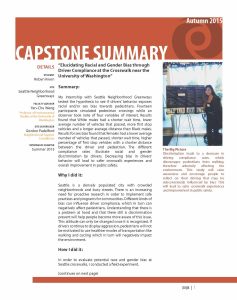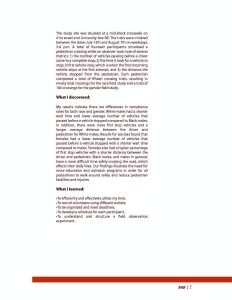Elucidating Racial and Gender Bias through Driver Compliance at the Crosswalk near the University of Washington
My internship with Seattle Neighborhood Greenways tested the hypothesis to see if drivers’ behavior exposes racial and/or sex bias towards pedestrians. Fourteen participants simulated pedestrian crossings while an observer took note of four variables of interest. Results found that White males had a shorter wait time, lower average number of vehicles that passed, more first stop vehicles and a longer average distance than Black males. Results for sex bias found that females had a lower average number of vehicles that passed, shorter wait time, higher percentage of first stop vehicles with a shorter distance between the driver and pedestrian. The different compliance rates illustrate racial and gender discrimination by drivers. Decreasing bias in drivers’ behavior will lead to safer crosswalk experiences and overall improvement in public safety.

